You’ve enjoyed your hot tub and now it’s time to change the water. Don’t worry, it’s not as daunting as it seems!
Start by turning off the power to your hot tub for safety. Next, locate the tub’s drain plug, usually found at the bottom of the tub, and remove it to let the water flow out. Once the tub is empty, clean it thoroughly before refilling it with clean water. Finally, add the necessary chemicals to balance the new water.
This guide will walk you through the whole process. We’ve got you covered with all the essential steps and tips.
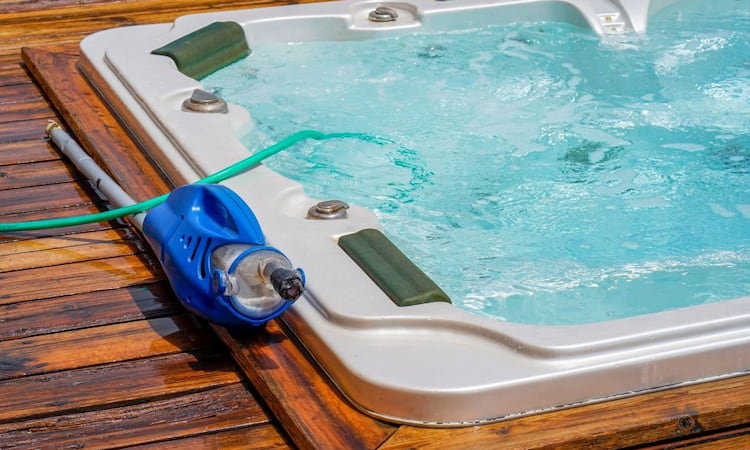
Quick Navigation
Gathering Necessary Supplies
Before diving into the process of changing your hot tub water, preparation is key, and that involves gathering all the necessary supplies.
Here’s a handy list of supplies you’ll need, presented in a markdown table for better clarity:
| Item | Purpose | To check the water balance |
|---|---|---|
| Hose | To fill and drain the tub | Garden hose |
| Submersible pump | For faster draining | Any brand from a home improvement store |
| Spa water test strips | To check water balance | Leisure Time Test Strips |
| Spa chemicals | To balance water | Leisure Time Bromine Tabs |
| Clean towels | For cleaning and drying | Any clean, absorbent towel |
Take a good look at this table and make sure you’ve got everything. The right supplies, when used correctly, will make changing your hot tub water a breeze.
It’s about precision and effectiveness. So, ensure you’re well-prepared before you start. Your hot tub and you will be grateful for a job well done.
Related Read: How Often to Change Hot Tub Water?
Draining the Existing Hot Tub Water
Now that you’ve gathered all your supplies, it’s time to get down to the task of draining the existing water from your hot tub.
The first step in this process is to turn off the power supply to your hot tub. You can’t take any chances with electricity and water. Safety first!
Once you’ve ensured that the hot tub’s power supply is off, locate the drain valve. It’s usually positioned at the bottom of the tub. Open this valve to start the draining process.
It’s worth noting that if your hot tub isn’t equipped with a draining valve, you’ll need to use a submersible pump.
As the water is draining, it’s a good idea to clean the tub’s interior. Use a soft cloth or sponge to wipe down the surfaces. This will prevent any dirt or grime from drying and sticking to the tub.
Cleaning and Preparing the Hot Tub
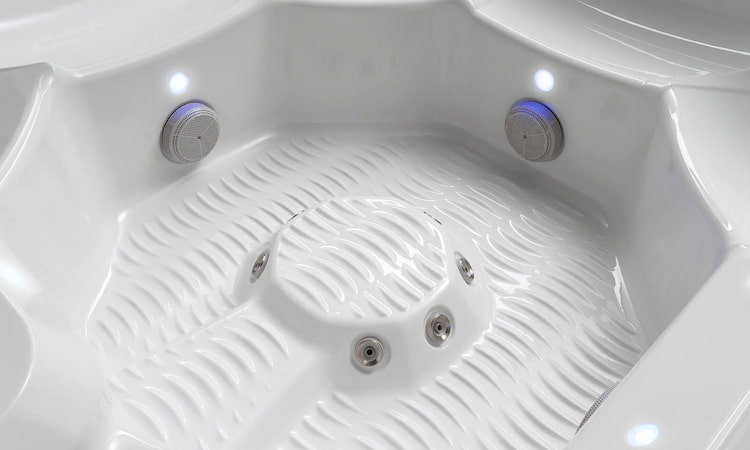
Often, it’s vital to thoroughly clean and prepare your hot tub before refilling it with fresh water. This is not just a matter of aesthetics, it’s also about maintaining the performance and longevity of your spa.
Start by wiping down the tub’s interior with a non-abrasive cleaner. Avoid harsh chemicals that could damage the tub’s surface and upset the water’s pH balance. You’ll want to pay extra attention to the water line, where mineral deposits and residues often build up.
Next, clean the filter. Remove it and rinse thoroughly with a garden hose to dislodge debris. For a deeper clean, soak the filter in a designated filter cleaner, then rinse again. This step is essential in ensuring clear, clean water flow.
Lastly, inspect the jets and drain. If there’s visible grime, use a small brush to clean these areas. Flush the lines with a line-flush product to remove any leftover residues.
Refilling and Balancing the Hot Tub Water
Once your hot tub is thoroughly clean, it’s time to fill it up with fresh water. But don’t just turn the hose on and walk away.
There are several important steps you should follow to ensure the water is balanced properly, to keep your hot tub functioning at its best and safe for you to use.
Fill the tub with water:
- Use a hose filter if possible. This will minimize the amount of minerals and other contaminants that get into your tub.
- Fill the tub to the appropriate level, which is typically about 6 inches from the top.
Balance the water:
- Test the water using test strips or a digital tester. You’re aiming for a pH level between 7.2 and 7.8, and an alkalinity level between 80 and 120 ppm.
- Use chemicals as needed to adjust these levels. Always add chemicals slowly, and wait at least 20 minutes before retesting.
Maintain the water:
- Regularly check and adjust the water balance. This will keep your hot tub working well and prolong its lifespan.
- Use a cover when the tub isn’t in use to keep debris out and maintain heat.
Related Read: Can You Fill a Hot Tub With Well Water?
Frequently Asked Questions
You shouldn’t skip rinsing the tub or ignore balancing pH levels. Neglecting to clean the filters or fully draining the tub are also mistakes. Always remember to turn off the heater before you start draining.
Changing your hot tub’s water impacts its performance significantly. Freshwater improves the efficiency of jets and heaters, reduces strain on the filtration system, and provides a more enjoyable, hygienic soak for you.
Yes, there are environmental concerns. Draining hot tub water directly into storm drains can harm local waterways as it contains chemicals. You should dechlorinate the water before draining or using it to water plants.
You don’t always need professional help for changing hot tub water. However, if you’re unsure or facing complications, a pro’s help every 3-4 months can ensure proper maintenance and longevity of your hot tub.
If you don’t regularly change your hot tub water, you’re risking bacterial growth, including Legionella. This can lead to skin, ear, and eye infections, or even Legionnaire’s disease, a severe form of pneumonia.
Conclusion
Changing your hot tub water isn’t a daunting task. It’s about knowing when to change it, having the right supplies, draining the old water, cleaning, and preparing the tub, and then refilling and balancing the new water.
It’s all about maintenance and ensuring a healthy, enjoyable soak. So, don’t let the task intimidate you. Keep on top of it and your hot tub will provide you with endless relaxation and enjoyment.


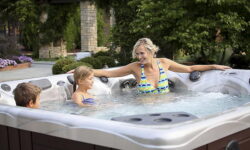
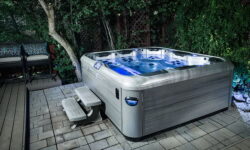
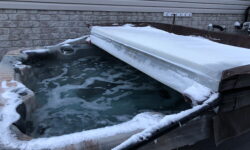
![Is Yellow Hot Tub Water Safe? [& Treatment Options] is yellow water in hot tub safe](https://hottubtales.com/wp-content/uploads/2023/10/is-yellow-water-in-hot-tub-safe-250x150.jpg)
![How Many Gallons of Water in a Hot Tub? [Different Sized Hot Tubs] how many gallons of water in a hot tub](https://hottubtales.com/wp-content/uploads/2023/10/how-many-gallons-of-water-in-a-hot-tub.jpg)